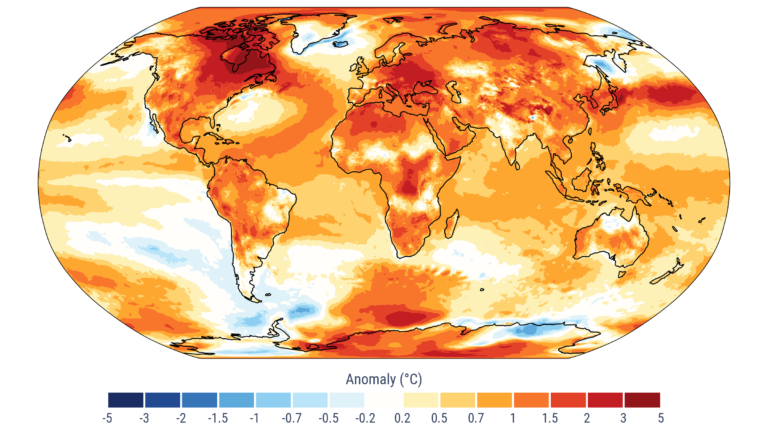Image: Surface air temperature anomalies for 2024 relative to the average for the 1991–2020 reference period. Data: ERA5. Credit: C3S / ECMWF.
The Copernicus Climate Change Service (C3S) has confirmed that 2024 was the warmest year on record globally, and the first calendar year that the average global temperature exceeded 1.5°C above its pre-industrial level.
C3S is implemented on behalf of the European Commission by the European Centre for Medium-Range Weather Forecasts (ECMWF), whose scientists have been monitoring key climate indicators and documenting unprecedented daily, monthly and annual temperature records over 2024.
According to the report, human-induced climate change remains the primary driver of extreme air and sea surface temperatures, while other factors, such as the El Niño Southern Oscillation (ENSO), also contributed to the unusual temperatures observed during the year.
Carlo Buontempo, director of C3S, ECMWF, commented, “All of the internationally produced global temperature datasets show that 2024 was the hottest year since records began in 1850. Humanity is in charge of its own destiny but how we respond to the climate challenge should be based on evidence. The future is in our hands – swift and decisive action can still alter the trajectory of our future climate.”
Monthly temperatures on the rise
The report shows that monthly temperature patterns provide a crucial clue to understanding some of the factors leading to 2024 becoming the hottest year on record. The first half of the year was particularly warm, with each month recording higher global temperatures than the same month in any previous year. This contributed to a 13-month streak of record-breaking monthly temperatures, which ended in June 2024.
From July onward, global temperature anomalies remained significantly above average. August 2024 was as warm as August 2023, and the other months from July to December ranked as the second warmest on record, behind 2023. Notably, July 22 marked the hottest day ever recorded, with the global temperature reaching 17.16°C, according to ERA5.
The persistence of exceptionally high monthly global average temperatures during the first half of 2024 made it likely from late summer that it would surpass 2023 as the hottest year on record. Furthermore, 2024 became the first year to register an annual temperature anomaly exceeding the 1.5°C threshold above the pre-industrial level. The two-year average for 2023-2024 also exceeds this threshold. While this does not mean we have breached the limit set by the Paris Agreement – this refers to temperature anomalies averaged over at least 20 years – it underscores that global temperatures are rising beyond what modern humans have ever experienced, according to ECMWF.
Samantha Burgess, strategic lead for climate, ECMWF, explained, “Each year in the last decade is one of the 10 warmest on record. We are now teetering on the edge of passing the 1.5ºC level defined in the Paris Agreement and the average of the last two years is already above this level. These high global temperatures, coupled with record global atmospheric water vapour levels in 2024, meant unprecedented heatwaves and heavy rainfall events, causing misery for millions of people.”
High sea temperatures globally
According to the report, high sea surface temperatures (SSTs) have been one of the most significant drivers behind the prevalence of high global temperatures in 2023 and 2024. One of the factors behind these high SSTs was the evolution of the El Niño Southern Oscillation (ENSO). This ENSO peaked in December 2023 and continued to influence global temperatures in the first half of 2024.
Even as the El Niño event ended and the transition toward more neutral conditions in the equatorial eastern Pacific took place, many regions continued to experience unusually high SSTs, resulting in the global SST remaining higher than average. In 2024, annual average SST across the extra-polar ocean were at a record high.
The persistent high temperatures also caused extreme weather events worldwide, ranging from severe storms and floods to heatwaves, droughts and wildfires, as well as record or near-record lows for Antarctic sea ice extent and below average sea ice extent in the Arctic.
Impact of greenhouse gases
The report also says the defining factor in the evolution of many key climate indicators in 2024 has been the increasing global temperature, which is largely associated with the increasing concentration of greenhouse gases (GHG) in the atmosphere, a consequence of human activities. Monitoring of GHGs provides information to support the implementation of mitigation policies. The rate of increase of carbon dioxide was larger than the rate observed in recent years. The rate of increase of methane was significantly lower than in the last three years.
Laurence Rouil, director of CAMS at ECMWF, said, “This report shows the critical value of our monitoring activities. In 2024, atmospheric GHG reached the highest annual levels ever recorded in the atmosphere, according to C3S and CAMS data. Carbon dioxide concentrations in 2024 were 2.9ppm higher than in 2023 and methane concentrations were 3ppb higher. This increase has brought the annual estimate of the atmospheric concentration of carbon dioxide to 422ppm, and of methane to 1,897ppb. Our data points clearly to a steady global increase of greenhouse gas emissions and these remain the main agent of climate change.”
The 2024 Global Climate Highlights full report can be accessed here: https://climate.copernicus.eu/global-climate-highlights?utm_source=pressrelease&utm_medium=referral&utm_campaign=gch24



